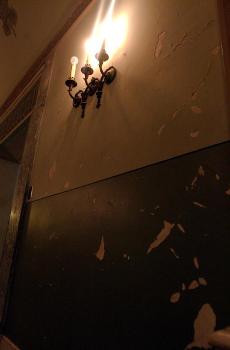Paying for more than just an education

Paint cracks off the walls in the Lincoln Hall Theatre on Tuesday afternoon. Tessa Pelias
June 14, 2006
The University of Illinois Board of Trustees approved a $500 per year fee for all incoming students to fund a ballooning backlog of maintenance repairs needed on campus buildings at its April 11 meeting. While University officials express regret on increasing student fees, they call the action necessary to address a multi-hundred million dollar problem.
While finding funding for deferred maintenance for the University is a priority, an important part of the plan also includes the incorporation of energy efficient conservation measures to reduce costs in the long term.
“Very central to that entire effort is going to be looking at all the old systems in these buildings and take a look at what we can do to make these enhancements to reduce energy,” said Lyle Wachtel, assistant vice president of the University office of facilities planning and programs.
Wachtel said that the University has two focuses on how to use the revenue from the new student fee: upgrading campus facilities and reducing energy costs.
However, the fund from the new student fee would only provide half of money the University expects to spend on deferred maintenance.
Get The Daily Illini in your inbox!
“We’re already spending money,” said University President B. Joseph White. “The problem is we’re only spending half of what we need to spend, which is why our problem keeps getting bigger.”
The University places an $800 million figure on its backlog of deferred maintenance. White said that maintenance experts say a responsible level of deferred maintenance is 10 percent of the book value of all the buildings. Currently, the book value of University facilities is $4.4 billion, making an acceptable level of deferred maintenance about $400 million, White said, and the problem is compounding by $40 million each year.
“The Board and I agree that we’ve got to get on top of the problem completely within 10 years,” White said.
While White said that the University supports the current budget to increase state appropriations to the University by 1.5 percent – about $10 million – he said the days of full state support are long gone.
“We’re counting on the state over the course of the next 10 years to provide 15 percent of the total of what we need to spend,” White said. “Even though, frankly, we have no idea if they will, because we haven’t had a capital budget from the state in four years.”
While repairing facilities is a primary objective for the University, energy efficiency also remains an important goal as well.
“If you take a look at trying to makes sense of reducing energy usage, we have to do it in a way that makes sense economically,” Wachtel said.
In July 2000, first steps were taken to conduct a University-wide audit to assess the conditions of facilities, which was completed in October 2002 and presented to the Board in November 2002. The report identified that a majority of deferred maintenance existed in the enclosures of buildings, the heating ventilation and air-conditioning systems, and electrical systems.
Wachtel said that those three areas each presented a way to conserve energy – and money – while doing upgrades on campus.
“The University has experience in construction for many years,” Wachtel said. “I think we’re all going to be lending our ability to address some of these experiences that are beneficial for the program.”
Campus Sustainability Coordinator Matt Malten said he thinks the University is on top of energy issues and knows what can be done to reduce campus energy use. Currently, the Energy Subcommittee on a Sustainable Campus Environment has received nine proposals to improve energy efficiency on campus, ranging from doing energy audits on buildings, implementing bio-diesel fuels and performing energy efficiency awareness campaigns in residence halls.
Malten said that one measure the University has taken to gauge energy efficiency is to track energy usage on each individual building on campus, which allows it to make decisions on how to make improvements.
“Just having that information as a starting point is really critical,” Malten said. “There’s a number of other campuses around the country that are just starting to have that.”
Students at the University have, in recent years, taken a stance to promote energy conservation and worked to pass a referendum to create a clean energy and technology fee to provide revenue for the University to spend on environmentally-friendly projects. Most recently, the fee has put money toward three wind-turbines to be constructed and provide a portion of the campus’ energy supply.
Jen Walling, chairperson for the Energy Subcommittee on a Sustainable Campus Environment and law student at the University, said she thinks the institution ranks as one of the top public universities in energy issues, but that it has a large potential to save even more.
“Five years ago, nobody really cared about (energy conservation) and now I think that people are really pushing it,” Walling said.
Walling said one problem with energy efficiency on campus is that on an administration level, the operating and construction budgets are in two separate pools.
“If you want to save money on your operating expenses, you can’t use money in the construction budget to buy new lights,” Walling said. “One budget doesn’t see the other one’s savings.”
Walling said she was horrified to learn that the University decided to increase fees for maintenance, when other measures could have been taken to save money, such as combining budget lines. She also said that plenty of government and private grants are available to pay for environmentally friendly projects that could also save more money.
“I think it’s really tragic that they went about it and just set a number and are making everyone pay when they really could have been smarter about how they did it,” Walling said.






